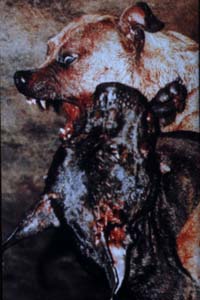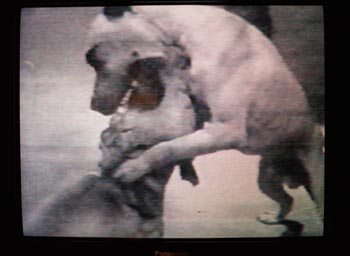![[Metroactive News&Issues]](/gifs/news468.gif)
[ San Jose | Metroactive Central | Archives ]
 Scar Issues: Humane Society workers say they frequently take in dogs that bear signs of having been fought, like the injury on this dog, seen in the Humane Society video 'The Final Round.' Blood Sport A spate of dogfighting arrests illuminates the dark underside of north Sunnyvale, where gang members, crank dealers and other model citizens engage in the cruelest of sports By Traci Hukill THE DOG ADOPTION ward at the Humane Society of Santa Clara Valley is a study in irrational optimism. Unlike cats, who plunge directly into despair upon finding themselves camped together in wire cages, the dogs don't quite seem to grasp the gravity of the situation. Even the dourest-looking pound hound usually harbors a flicker of hope, lifting its head and thumping its tail if someone simply squats down at its cage and waves a couple of fingers at it. The young dogs are especially oblivious. Take "Turbo," a 6-month-old pit bull puppy picked up as a stray in a south San Jose neighborhood. He flops up to the fence in too-big feet, ears swinging, and tries to lick his visitors to death through the wires of his cage. Tan and white with the classically beautiful wide pit head, he's all velveteen muzzle and sleek coat, rubbing his head and neck against the fingers at the fence. He's friendly and unscarred, a dog who's been treated well, and a laminated placard hanging on his cage discourages people who would have any other plans for him. "I am a pit bull puppy mix," the card reads. "In order to adopt me you will need to..." Two training classes (completion ensured by deposits), no small children in the family and alteration prior to leaving the shelter will all be conditions of Turbo's adoption, part of an effort to protect him from the unhappy fate of other pit bulls at this shelter. Cosmopolitan Silicon Valley isn't a place most people would expect to find the brutal sport of dogfighting. But on June 17 Sunnyvale police confiscated five dogs and arrested five men aged 14 to 24 on charges of dogfighting in Orchard Gardens Park off 101 at Mathilda Avenue. Police officials say these were the first dogfighting arrests in Sunnyvale in recent memory. Unfortunately, it was not an isolated incident. Other arrests have since followed. Currently, locked away in concrete runs behind "employees only" signs at the shelter, are six abused adult pit bulls and four puppies seized in the last two months from owners believed to be dogfighters. Each dog awaits a determination of temperament by the shelter's animal behaviorist. All of these dogs were found in the backyards of two north Sunnyvale homes, along with dogfight training paraphernalia, drugs, cockfighting implements and, at one house, gamecocks and guns. The adult dogs bear telltale scars on their heads and necks that indicate they've been fought. The chances they'll be adopted instead of euthanized are exceedingly slim; the shelter's stated policy is not to adopt out adult pit bulls, and most won't pass the temperament assessment anyway. Signs of aggression toward humans or other animals carry an automatic death sentence here. The 10 pit bulls now in residence at the shelter are being held as evidence in pending cases against their owners and are unavailable for viewing. But they can be heard. As visitors walk past the kennels marked "employees only," a chorus of barks and howls erupts, including a long, low wail that sounds like a mournful siren--a note of exception to the rule of canine optimism that prevails here. Man's Best Friend DOGFIGHTING IS A dangerous, bloody, secretive sport that is a felony in 43 states, including California. Though dogs are better protected than gamecocks (cockfighting is a felony in only 17 states, California not among them), the laws are still spotty. Only 27 states consider it a felony to possess dogs for the purpose of fighting, meaning that in order to be seriously prosecuted, a dogfighter must be caught mid-fight--with blood on his hands, so to speak. And there will inevitably be blood on the hands of anyone caught fighting a dog. In an educational video released by the Humane Society of the United States titled The Final Round, grisly footage shows one dog on its back, belly dark and slick with blood, kicking feebly at its still-attacking opponent while onlookers cheer. In another scene a bleeding dog with a broken front leg tries to hide behind its owner in the ring, tail between its legs, as another dog comes after it. Eric Sakach directs the Humane Society's West Coast regional office in Sacramento. He is also one of the country's foremost experts on dogfighting, having helped bust numerous dogfighting rings, and he delivers training programs to law enforcement departments around the country. Sakach divides dogfighters into three groups: professionals, hobbyists and streetfighters, and he says all three are increasing in number. Professionals work in national and even international networks, competing for purses worth up to $40,000 and taking great pains to ensure the security of staged fights. They develop bloodlines in search of "gameness," or willingness to fight, and may own dozens of dogs. Hobbyists are smaller time, less interested in bloodlines and more focused on gambling. They typically use a single location for staged fights rather than travel around the country as professionals do. And finally there are streetfighters--the group Sakach claims is the fastest growing group. Often associated with gang activity, streetfighting usually happens in areas that are depressed economically. It's far less organized than professional or hobby fighting, and while participants often wager, streetfighting is as much about machismo as winning money. "Fights are held in an impromptu manner," says Sakach, "often in quasi-public areas, like parks or schoolyards, because people are walking their dogs in public areas in order to be visible. It can involve people who range in age from preteen on up." That definition makes the arrest that happened in Sunnyvale's Orchard Gardens Park on June 17 practically textbook.
from 'The Final Round'
Witness to Carnage LATE ON A Thursday evening, with light still streaking the sky, a neighbor of the long narrow park just north of Highway 101 off Mathilda called police to report a dogfight in progress. When eight police arrived and surrounded the park, people and dogs started running. In minutes, police had apprehended all 10 suspects, aged 14 to 25, and five dogs. One minor and four adults were booked for dogfighting and the rest, mostly minors, were cited and released for watching (being a spectator at a dogfight is a misdemeanor in California). The Humane Society promptly quarantined four of the dogs and put the fifth in the hospital to recover from "fresh lacerations and puncture wounds," as the police report describes them. All five dogs bore scars "consistent with fighting." The plot took an intriguing turn on the night of Saturday, June 19, when unknown suspects broke into the Humane Society and released three dogs. "Honey," a light brown female with a white chest, and "Capone," described as an "aggressive" 6-month-old male, disappeared for good. The third dog was found wandering not far from the shelter on the evening of Sunday the 20th. Santa Clara police investigated the incident (the shelter is located in the city of Santa Clara) but dropped the case for lack of evidence. District attorney Scott Sui, who is handling the case against the individuals arrested for dogfighting, has filed no charges to date. He says he's gathering evidence but declines to comment otherwise. Perhaps he's buried beneath an avalanche of information. The adult suspects are no angels. Jorge Meza, 20, was arrested a year and a half ago and charged with assaulting a man during a fight between Norteños and Sureños. He is identified in the police report as a "known member of the Norteños gang." Omar Navarro, now 20, hadn't been out of Holden Boys Ranch for long when police came knocking at his grandmother's door looking for him in May 1998. They found methamphetamine under a pillow in a doghouse (according to the police report, Navarro claimed he'd put it there so no children would find it and hurt themselves) and $670 in cash. Navarro was already in trouble with his probation officer for being in contact with known gang members and felons. Clifford Ohotto, 25, was charged in November 1998 with possession for sale of methamphetamine; police also found $2,298 in cash, a scale, a little bit of pot and some baggies. Then on June 20, 1999, the same day Honey and Capone were reported missing from the Humane Society, Clifford Ohotto was arrested on two counts of exhibiting a deadly weapon at a motorist. Hector Jacobo and Gilbert Cortimus identified Ohotto as the man who pursued them through the streets of Sunnyvale in a black mid-'90s Lexus, ultimately brandishing a small black semiautomatic pistol at them and abandoning the chase only when Jacobo pulled into a fire station. Jacobo and Cortimus testified that Ohotto drove off toward Lawrence Expressway at that point. Moments later a truck driver towing a car on El Camino Real says a small black gun hit his truck and slid underneath it. He thinks it came from the Lawrence Expressway overpass. In early September, between various of Ohotto's court dates for his methamphetamine and gun cases, two of the dogs seized in the June 17 arrest, "Chata" and "Tito," were judged vicious and put to sleep.
Sadistic Pastime THIS WAS THE FIRST dogfighting incident anyone at the Sunnyvale public information office could recall, but it wasn't to be the last. On Aug. 25, Sunnyvale police responded to a complaint by a neighbor about animals at 766 Lakebird, just off Lawrence Expressway near Tasman. The officers were invited into the backyard to take a look and saw three adult pit bulls, 33 game fowl (including roosters possibly used for fighting) and evidence that the dogs were being trained to fight. Upon returning with a search warrant they found a half ounce of methamphetamine, four marijuana plants in the yard, several handguns and cockfighting paraphernalia (Capt. Chuck Eaneff, Sunnyvale's public information officer, won't say what kind of dogfighting or cockfighting apparatus the officers found). The officers arrested 27-year-old Leopold A. Bajala and shipped the three dogs off to the Humane Society. Then on Oct. 5, neighbors of Luis and Alysia Silva on Duane Street in north Sunnyvale (one block from Clifford Ohotto's listed residence) called the police complaining about stray dogs. Animal control unit officer Michelle Morgan responded, spotted a pit bull bitch and her four puppies roaming the street, and followed them home. As she closed the backyard gate behind the dogs, says Eaneff, Morgan saw marijuana plants. She alerted the narcotics unit, who returned to the house with a search warrant and found two more adult pit bulls chained to cement slabs, 19 marijuana plants, a treadmill thought to be used for training the dogs, and empty chicken coops. There were also other dogfighting training tools and evidence of cockfighting, although Eaneff would not specify what they were. Eaneff notes the dogs were ill cared for and had unhealed injuries. Luis and Alysia Silva were booked on counts of cruelty to animals, possession of animals for fighting (a felony in this state), cultivation of marijuana and possession for sale of marijuana. Their three children were placed in the custody of Child Protective Services. Dogfighting arrests are rare. Neither the sheriff's department nor San Jose police can recall any incidents within their jurisdictions over the past few years, but most local law enforcement officials chant the same refrain: We're sure it happens all the time. Humane Society officials back them up, saying they frequently take in dogs bearing signs of having been fought. So far Sunnyvale is the only municipality to uncover an appreciable number of dogfighters. Eaneff bridles a little at the suggestion that that's an indication of Sunnyvale's character. Rather, he says, it reflects the fact that the city devotes a police unit to animal control, unlike other cities in the county. "And they do a great job," he says. "It's easy to go to the fence and close it, but when you see a dog being neglected, it turns into a 100-page report." It's impossible to say how many dogfights go undetected in this county every month. But judging from the trend this summer and fall, it's a far greater number than anyone in this sophisticated pocket of the world would ever want to believe. [ San Jose | Metroactive Central | Archives ]
|
From the October 21-27, 1999 issue of Metro, Silicon Valley's Weekly Newspaper.
Copyright © 1999 Metro Publishing Inc. Metroactive is affiliated with the Boulevards Network.
For more information about the San Jose/Silicon Valley area, visit sanjose.com.
 Witness for the Persecution: 'The Final Round,' an educational video released by the Humane Society of the United States, shows grisly footage of dogfights.
Witness for the Persecution: 'The Final Round,' an educational video released by the Humane Society of the United States, shows grisly footage of dogfights.
